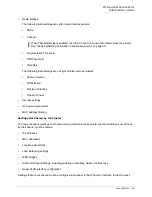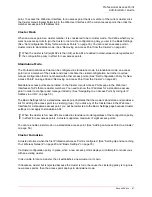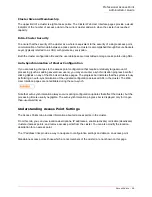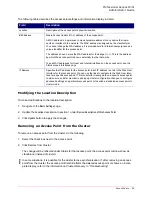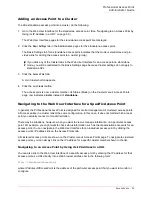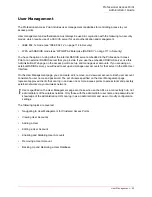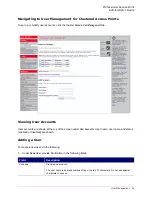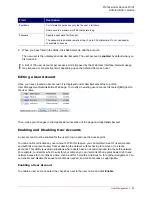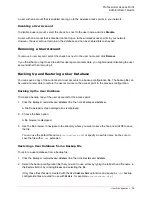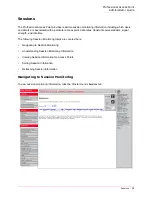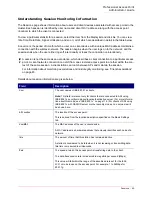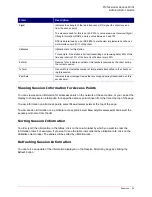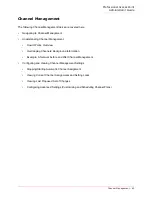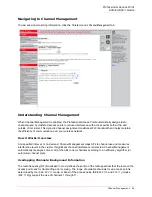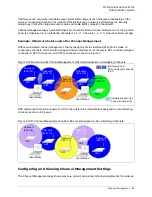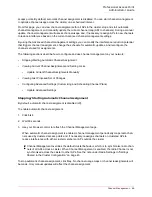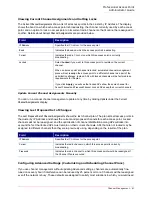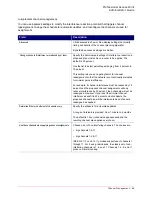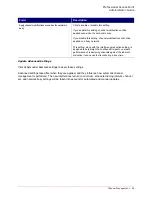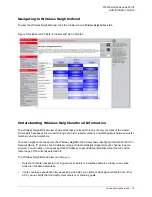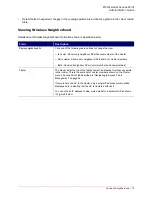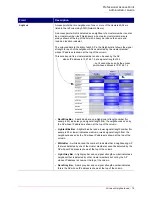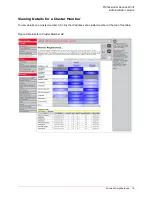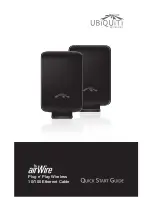
Professional Access Point
Administrator Guide
Sessions - 60
Understanding Session Monitoring Information
The Sessions page shows information about users and client devices associated with access points in the
cluster. Each session is identified by user name and client
MAC
address, along with the access point
(location) to which the client is connected.
To view a particular statistic for a session, select the item from the
Display
list and click
Go
. You can view
Idle Time, Data Rate, Signal, Utilization, and so on; all of which are described in detail in the table below.
A
session
is the period of time for which a user on a client device with a unique MAC address maintains a
connection with the wireless network. The session begins when the user logs on to the
network
, and the
session ends when the user either logs off intentionally or loses the connection unintentionally.
Details about session information are given below.
Note
A
session
is not the same as an
association
, which describes a client connection to a particular access
point. A client network connection can shift from one clustered access point to another within the con-
text of the same session. A client station can roam between APs and maintain the session.
For information about monitoring
associations
and
link integrity monitoring
, see “Client Associations”
on page 83.
Field
Description
User
The user names of IEEE 802.1x clients.
Note:
This field is relevant only for clients that are connected to APs using
IEEE 802.1x security mode
and
local authentication server. (For more informa-
tion about this mode, see “IEEE 802.1x” on page 114.) For clients of APs using
IEEE 802.1x with RADIUS server or other security modes, no user name will
be shown here.
AP Location
The location of the access point.
This is derived from the location description specified on the Basic Settings
tab.
User MAC
The MAC address of the user’s client device.
A
MAC
address is a hardware address that uniquely identifies each node of a
network.
Idle
The amount of time that this station has remained inactive.
A station is considered to be idle when it is not receiving or transmitting data.
Idle time is measured in milliseconds.
Rate
The speed at which this access point is transferring data to the client.
The data transmission rate is measured in megabits per second (Mbps).
This value will fall within the range of the advertised rate set for the
IEEE
802.1x
mode in use on the access point. For example, 1 to 54Mbps for
802.11g.
Summary of Contents for Instant802 APSDK
Page 1: ...Professional Access Point Administrator Guide R46 1224 00 rev 2 0 07 06...
Page 2: ......
Page 4: ...Professional Access Point Administrator Guide iv...
Page 8: ...Professional Access Point Administrator Guide viii...
Page 42: ...Professional Access Point Administrator Guide Basic Settings 42...
Page 52: ...Professional Access Point Administrator Guide Access Points 52...
Page 58: ...Professional Access Point Administrator Guide User Management 58...
Page 62: ...Professional Access Point Administrator Guide Sessions 62...
Page 70: ...Professional Access Point Administrator Guide Channel Management 70...
Page 88: ...Professional Access Point Administrator Guide Neighboring Access Points 88...
Page 96: ...Professional Access Point Administrator Guide Ethernet Wired Settings 96...
Page 120: ...Professional Access Point Administrator Guide Security 120...
Page 128: ...Professional Access Point Administrator Guide Virtual Wireless Networks 128...
Page 134: ...Professional Access Point Administrator Guide Radio 134...
Page 138: ...Professional Access Point Administrator Guide MAC Filtering 138...
Page 152: ...Professional Access Point Administrator Guide Quality of Service 152...
Page 160: ...Professional Access Point Administrator Guide Wireless Distribution System 160...
Page 164: ...Professional Access Point Administrator Guide Time Protocol 164...
Page 170: ...Professional Access Point Administrator Guide SNMP 170...
Page 290: ...Professional Access Point Administrator Guide Configuration Troubleshooting 290...
Page 298: ...Professional Access Point Administrator Guide Regulatory Information 298...
Page 328: ...Professional Access Point Administrator Guide Index 328...

